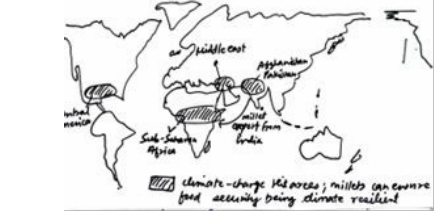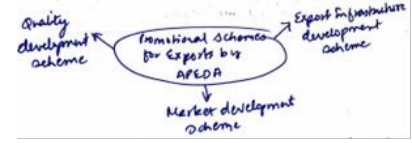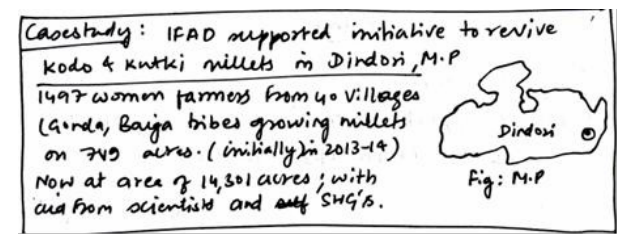
Millets, often hailed as “nutri-cereals,” have emerged as a focal point in the discourse surrounding sustainable and nutritious agriculture. These ancient grains, including sorghum, pearl millet, finger millet, foxtail millet, and proso millet, are celebrated for their exceptional nutritional value, gluten-free nature, and remarkable adaptability to diverse climates. Termed as “nutri-cereals” due to their rich composition of essential nutrients such as fiber, protein, and micronutrients, millets play a pivotal role in addressing malnutrition and promoting food security. Moreover, millets are recognized for their climate-resilient characteristics, thriving in conditions where other crops might falter. Despite these advantages, millet cultivation faces various constraints in India, including insufficient awareness, limited research and development support, and market challenges. This introductory paragraph aims to delve into the dual identity of millets as nutri-cereals and climate-resilient crops while shedding light on the existing obstacles and potential opportunities in their cultivation within the Indian agricultural landscape.
Contents
Answer
Millets are small seeded grams that are adapted to dry land ecologies of the arid and semiarid topics. E.g. sorghum, pearl-millet, finger-millet etc.
They are called nutri-cereals because:
- Provide most nutrients required for a healthy lifestyle. E.g. protein 7-12%, fats 2-5%, carbohydrates 65-75%, 15-20% dietary fibres along with iron and phosphorus.
- High antioxidant activity such as phytates, tannins, polyphenols etc. beneficial in aging and metabolic diseases.
Further they are climatic-resilient as:
- High ability to withstand droughts: due to deep root system allowing water access from deep soil.
- Resistant to extreme heat: high yield even in hot spells.
- Resistant to floods: high tolerance for standing water.
- Reduced need for fertilizers: due to nitrogen fixation ability


Given the following characteristics, millets are most suitable for indian climate, yet there are following constraints in their cultivation:
- Declining consumption: mainly due to green revolution in india and increased attention to foodgrain crops for food security, production dropped from 40% to 20% over the years.
- Change in taste preferences: with rising globalisation and availability of other cereals e.g. wheat, all purpose flour etc. people have developed less liking for traditional coarse cereals.
- Low productivity/traditional farming methods: traditional farming methods like ‘broadcasting the seeds’ as well as long maturity cycle(75-90 days) and weeds have led to low productivity( only 1247 kg/ha).
- Constraints in millet processing: due to low recovery of 70-80% grains along with low shelf-life of millets of millet-processing machines.
Also need for dual-dehauller( double-staged dehauller) due to unhulled and broken grains.
Opportunities for millet cultivation india:
India produces 38% of global production of millets.(80% of asia). There are ample opportunities for increasing millet production:
- High demand in Food processing:
● More than 500 startups in millets value added chain.
● Along with 250 startups under rashtriya krishi vikas yojana to cater to demand of 1.3 billion. - High export potential:
● millet exports have increased by 11.6% in 2022-23.( $40 million) with a cagr of 3% over the
decade.
● Major varieties are bajra, ragi, jowar, buckwheat.● Various export startups such as Mantra, Manna foods have shown the vast opportunity in millet exports.

- Domestic market demand:
● Millets based meals are being mainstreamed in india. E.g. millets based dishes served to G20 guests in hotels.
● Due to government’s vision of ‘SHREE ANNA’, msp for millets has been increased by 8-10%
to support the production of millets. - Support to grassroot production in villages to increase rural income and food security:

By declaring 2023 as ‘ the international year of millets’, UNGA has set the tone for increasing teh production of millets across the world. India should also grab the opportunity with both hands to materialise SDG 2 of zero hunger by 2030.
In case you still have your doubts, contact us on 9811333901.
For UPSC Prelims Resources, Click here
For Daily Updates and Study Material:
Join our Telegram Channel – Edukemy for IAS
- 1. Learn through Videos – here
- 2. Be Exam Ready by Practicing Daily MCQs – here
- 3. Daily Newsletter – Get all your Current Affairs Covered – here
- 4. Mains Answer Writing Practice – here

